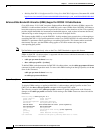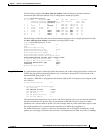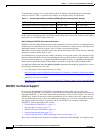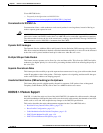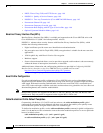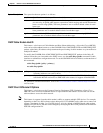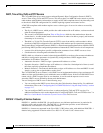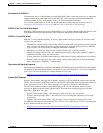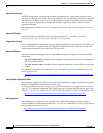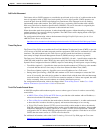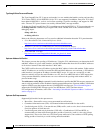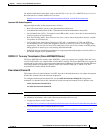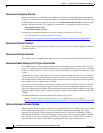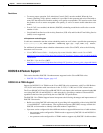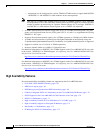
1-61
Cisco uBR7200 Series Universal Broadband Router Software Configuration Guide
OL-2239-05
Chapter1 Overview of Cisco uBR7200 Series Software
Supported Software Features for the Cisco uBR7200 Series
Concatenation for DOCSIS 1.1
Concatenation allows a cable modem to send multiple MAC frames in the same time slot, as opposed to
making an individual grant request for each frame. This avoids wasting upstream bandwidth when
sending a number of very small packets, such as TCP acknowledgement packets.
You can turn concatenation on or off. For information about configuring concatenation, refer to
Configuring Concatenation on the Cisco uBR7200 Series Cable Router on Cisco.com.
DOCSIS 1.0 and 1.0+ Cable Modem Support
DOCSIS 1.1 cable modems can coexist with DOCSIS 1.0 and 1.0+ cable modems in the same network—the
Cisco uBR7200 series provides the levels of service that are appropriate for each cable modem.
DOCSIS 1.1 Service Flow Model
DOCSIS 1.1 offers enhanced Quality of Service (QoS) features that give priority for real-time traffic
such as voice and video:
• The DOCSIS 1.0 QoS model (a Service IDs (SID) associated with a QoS profile) has been replaced
with a service flow model that allows greater flexibility in assigning QoS parameters to different
types of traffic and in responding to changing bandwidth conditions
• Multiple service flows per cable modem in either direction due to packet classifiers
• Support for multiple service flows per cable modem allowing a single cable modem to support a
combination of data, voice, and video traffic.
• Greater granularity in QoS per cable modem in either direction, using unidirectional service flows
• Dynamic MAC messages that can create, modify, and tear-down QoS service flows dynamically
when requested by a DOCSIS 1.1 cable modem
Downstream QoS Handling Supported
Downstream QoS handling is compliant with Multimedia Cable Network System (MCNS) requirements.
For additional downstream QoS feature configuration, refer to the DOCSIS 1.1 for the Cisco uBR7200
Series Universal Broadband Routers feature module on Cisco.com:
http://www.cisco.com/univercd/cc/td/doc/product/cable/cab_rout/ub7200sw/index.htm
Dynamic MAC Messages
Dynamic Service MAC messages allow dynamic signaling of QoS between the cable modem and the
CMTS. These messages are DOCSIS link layer equivalents of the higher layer messages that create, tear
down, and modify a service flow. These messages are collectively known as DSX messages.
The DSX state machine module on the CMTS manages the several concurrent dynamic service
transactions between cable modems and the CMTS. It include state machine support for all three
DOCSIS1.1 DSX MAC messages:
• Dynamic Service Add (DSA)—This message is used to create a new service flow.
• Dynamic Service Change (DSC)—This message is used to change the attributes of an existing
service flow.
• Dynamic Service Deletion (DSD)—This message is used to delete an existing service flow.
For additional information, refer to the DOCSIS 1.1 for the Cisco uBR7200 Series Universal Broadband
Routers feature module on Cisco.com:
http://www.cisco.com/univercd/cc/td/doc/product/cable/cab_rout/ub7200sw/index.htm




